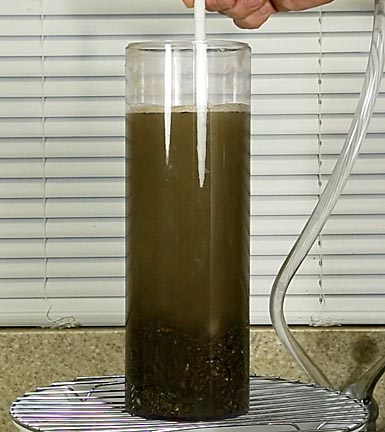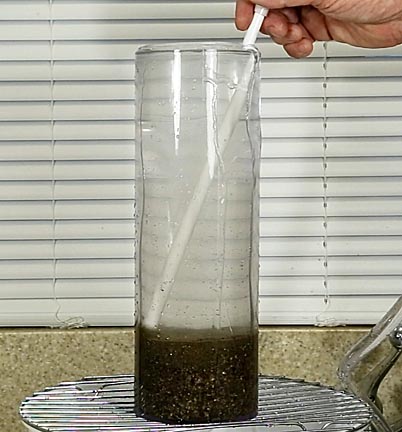

Whether
you pan, use a Miller table, blue bowl or spiral
wheel, nothing ruins the enjoyment
of
looking for gold in paydirt faster than having to deal with muddy water.
Here's
how to avoid that frustration.
Most gold paydirt contains enough silt and clay to make processing water so muddy that it's impossible to see the gold you're working so hard to find. Fortunately, theres an easy way to get rid of it when you are only dealing with one to three pounds of paydirt.

Using a clear container isn't necessary, but makes it more fun.
Take a clear, 12-inch tall by 4-inch in diameter plastic container and place the raw paydirt in it. Add 1/4 cup of Jetdry to prevent the gold's hydrophobic nature from enabling it to float. Attach a flexible hose to a water source and set the water flowing so slowly that it takes at least 30 seconds to fill the container. This is many times slower than even the smallest piece of gold falls through water so there is little chance that any gold will be washed away. Attaching a length of stiff tubing to the end of the hose will allow you to stir the paydirt to ensure that all the silt and clay is washed out of it.
Removing the aerator if a kitchen faucet is used will reduce the number of bubbles created by the turbulent water flow through the aerator causing dissolved air to come out of solution. If one of these bubbles touches a piece of gold, it could attach and create enough buoyancy for the gold to float up and out of the container.
Because silt and clay remain suspended in the water column for long periods of time, as fresh water flows in, the muddy water will spill over the top and be removed. After ten minutes the paydirt will be clean. The water will still look cloudy because it takes a long time to dilute it with enough fresh water to make it look clear. To speed things up, turn the water off, wait a few seconds for the larger particles to settle, then gently pour out most of the cloudy water.
After refilling with fresh water, the container should look like this:

Stirring may kick up a little sediment, but this should settle almost immediately when the flow is shut off.
Spread the paydirt out in a thin layer on a cookie sheet and bake it in a low oven for 15 minutes to dry it out. You now have clean paydirt that won't turn your processing water into mud. You'll also find that the paydirt classifies faster and cleaner.
The big question is: Does any gold get washed away?
To answer this I collected all the water that spilled over the top of the container and processed it over a Miller table. Here's what I found:

On the right we have all the gold collected from the paydirt, in this case 2.146 grams from a one-pound Liberty bag from Klondike Klinkers. There is everything from 1/3-gram nuggets to many specks all the way down to -100-mesh. On the left is what was found in the waste water: only two tiny pieces of 100-mesh gold. These are so small that a dozen weigh less than 0.001 grams. I find such a small loss is well worth it for the pleasure and convenience of working the paydirt in crystal clear water.
If you'd like to see a live action version of this page, please click on the following YouTube video:
Return to my main page to browse 60 other subjects